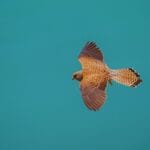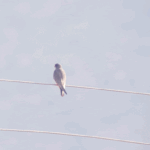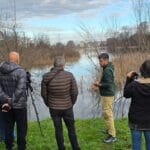Bird ringing is an important process and method for researchers and conservationists that work with avifauna. It provides us useful information on the biology, productivity and movements of birds, helping us to monitor bird populations and their development.
There have been years since the bird ringing is being used for scientific purposes. It all started in Denmark, in 1899, when Hans Christian Cornelius Mortensen ringed Common Starlings, using metal rings engraved with successive numbers.
AOS – Albanian Ornithological Society has been involved with bird ringing since 2015, collaborating with MME, BirdLife Hungary, assisting every year in their camps set up in Shkodër (Velipojë), Lezhë (Tale), Durrës (Rrushkull), Butrint (Liqeni i Bufit), Vlorë (Orikum), Divjakë.
On 7-12 October 2019, we were in Tale (Lezhë) to set up a bird ringing camp in order to continue our 5-year tradition on bird ringing. This is the first bird ringing camp lead and applied thoroughly by Albanian ornithologists!
The camp took place in the coastal area of Tale where reed habitats were selected to set up our mist nests due to their important role as a shelter for many migratory and non-migratory birds. As in the previous years, the camp was focused on the study of the important habitats of Moustached Warbler (Acrocephalus melanopogon) and in the verification of its population in these habitats.
In six days, more than 100 birds were ringed, representing circa 15 bird species, such as: Sedge Warbler (Acrocephalus schoenobaenus), Savi’s Warbler (Locustella luscinioides), Bluethroat (Luscinia svecica), Common Kingfisher (Alcedo atthis), Water Rail (Rallus aquaticus), Common Reed Bunting (Emberiza schoeniclus), Eurasian Blue Tit (Cyanistes caeruleus), Willow Warbler (Phylloscopus trochilus), etc. Among whom, 5 individuals of Moustached Warbler (Acrocephalus melanopogon).
Bird ringing is a process that requires high responsibility and full dedication. Thus, our team started the day early in the morning (at 5 am), setting up the mist nets and ended it in the sunset when the first howlings of jackals were heard. All the bird ringing work included several steps:
- Mist nets check which was carried out every 30 minutes in the first hours of the morning when the birds’ activity was at its peak and every one hour during the day due to low activity of birds.
- Taking birds from the nets is one of the steps that requires a careful handling in order to avoid any possible damage to the birds.
- Bird ringing is also a process that should be applied carefully. It consists on placing a metal ring in one of the bird’s legs. The ring serves as a barcode to distinguish one individual from another.
- Measurements and identification of the birds: After the ring is placed in one of the bird’s leg, a number of measurements are applied, such as: measurements of muscles and fat, weight, length of the wing, age, etc.
- Recording of the data: All the data (number of the ring and all other data from the measurements) is recorded in a notebook (specifically designed for this purpose) and every year this data is reported to Euring, contributing thus in the international database for bird ringing.
“Bird ringing camp – Tale 2019” is one of many other bird ringing camps that will be carried out in the future which will serve us not only for scientific purposes but also as a tool for the education of the Albanian society and especially for the education of young generations to love and protect nature, and birds in particular.
Photo credits: Liridon Shala





